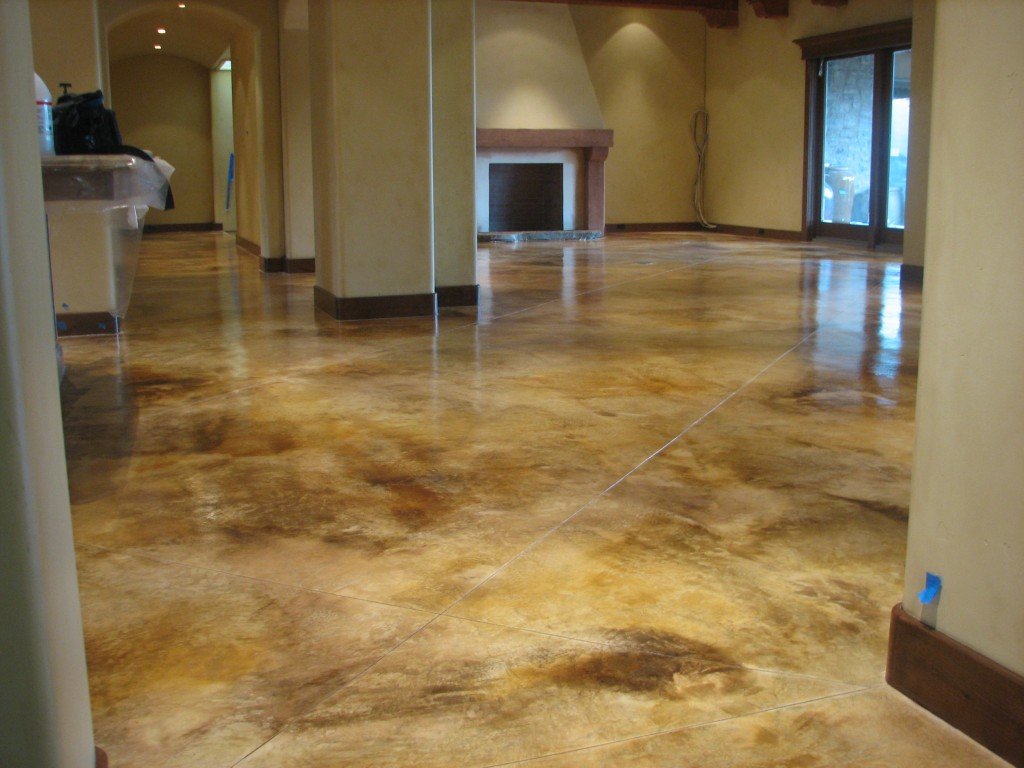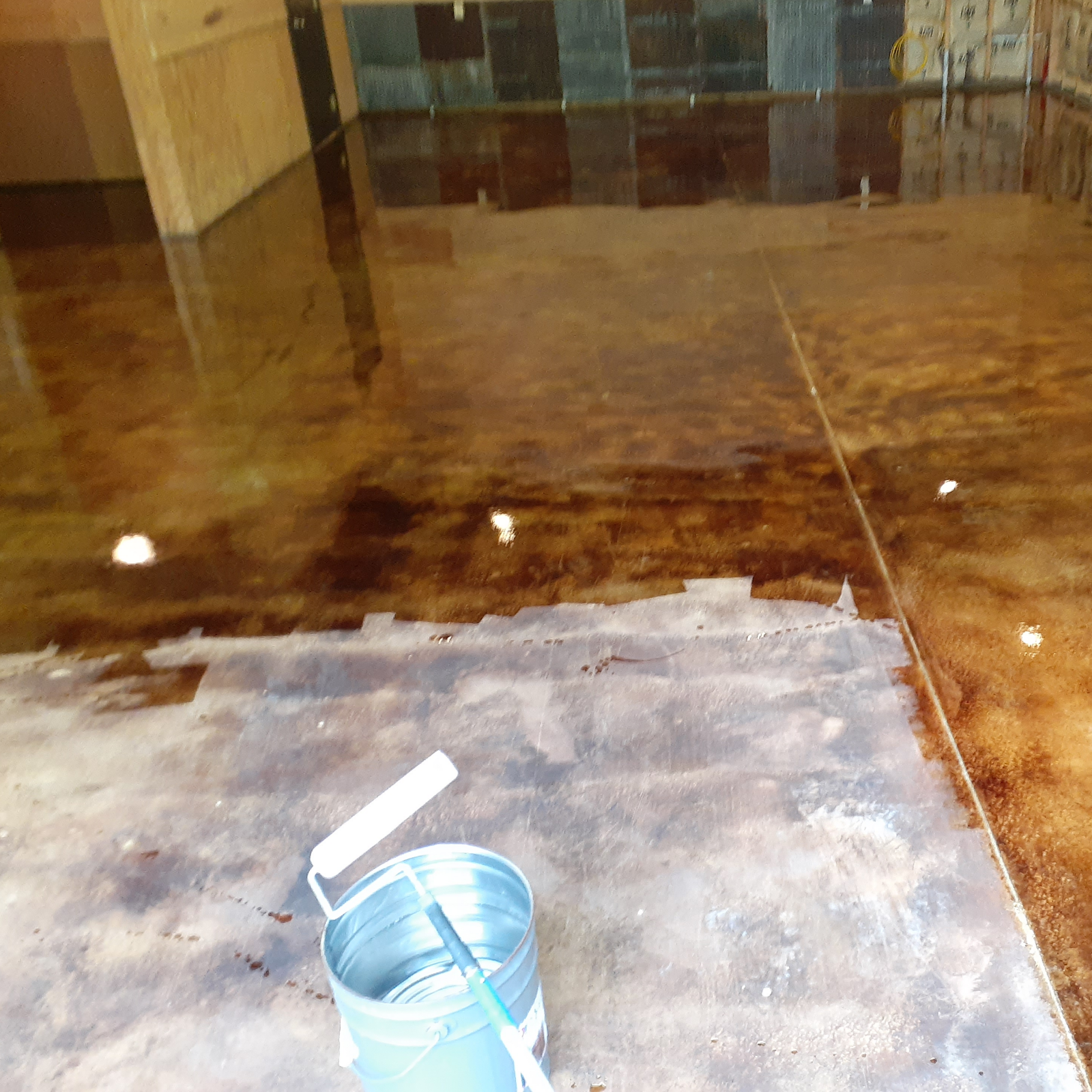The cost breakdown of stained concrete floors austin
Comprehending the Various Sorts Of Stained Concrete for Your Next Task
Stained concrete offers numerous choices that accommodate different visual and useful needs. Each type presents distinct qualities that affect the last appearance and longevity of the surface area. Understanding these distinctions is crucial for any person planning a task. From abundant, chain reactions of acid-based stains to the vibrant harmony of solid shade stains, the selections can substantially affect the result. What variables should one think about when picking the suitable stain for their details demands?
Overview of Stained Concrete
Stained concrete acts as a functional flooring choice that can boost the aesthetic appeal of various areas. This technique includes applying a tinting representative to the surface area of existing concrete, enabling a wide spectrum of style possibilities. Stained concrete is preferred in both property and industrial environments, using a durable and low-maintenance solution that can imitate the appearance of all-natural products like stone or tile.
The staining procedure can be performed making use of water-based or solvent-based items, each supplying distinctive visual effects. The final look is influenced by elements such as the original concrete surface area, the kind of stain made use of, and the application technique. Stained concrete not just beautifies exterior and interiors however additionally promotes sustainability by renewing existing concrete frameworks. As a result, it has actually acquired grip amongst homeowners and designers looking for both functionality and design in their flooring options.
Acid-Based Stains: Features and Advantages

Special Shade Variants
Concrete surface areas can transform dramatically with the application of acid-based stains, which offer a rich scheme of unique color variations. These stains penetrate the concrete, reacting chemically to produce lively planet tones that vary from deep browns and reds to soft environment-friendlies and blues. The resulting hues are usually variegated, developing a natural, marble-like look that enhances the concrete's character. Each application yields distinct results because of variations in the concrete's make-up and the discoloration strategy utilized, making every project unique. Additionally, acid-based stains can be split or combined with various other techniques to develop tailored designs, permitting personal expression. This convenience makes acid-based stains a preferred choice for both residential and commercial applications.
Chemical Responses Discussed
While numerous elements contribute to the efficiency of acid-based stains, the underlying chain reaction play a crucial role in their distinct features and advantages. These stains largely include water, acid, and metal salts. When related to concrete, the acid responds with the calcium hydroxide in the concrete, creating a chemical makeover that results in permanent shade modifications. The metallic salts permeate the surface and bond with the concrete, permitting a wide range of colors and tones. This response not just boosts aesthetic appeal however likewise supplies sturdiness, making the color resistant to fading and wear. Furthermore, acid-based stains can produce a variegated finish that imitates natural stone, additional improving their popularity for ornamental concrete applications.
Surface Area Prep Work Value
Attaining ideal outcomes with acid-based stains depends upon thorough surface area preparation. This crucial action warranties that the concrete surface is clean, without impurities, and correctly profiled for ideal stain absorption. Any existing sealants, dust, or oils can prevent the chemical response that generates the desired shade and surface, causing irregular or irregular results.
Prior to using the discolor, the concrete must be mechanically cleaned or stress washed, complied with by a detailed inspection for fractures or blemishes that may call for repair service. Furthermore, confirming the surface is sufficiently dried will enhance stain adherence. By prioritizing these primary measures, the durability and vibrancy of acid-based stains can be considerably improved, causing an extra cosmetically pleasing and long lasting coating.
Water-Based Stains: Functions and Advantages

Water-based stains pass through the concrete, providing a much more translucent surface that highlights the all-natural appearance and variants of the surface below. They are readily available in a broad variety of shades, allowing for innovative adaptability in layout. Additionally, water-based stains are much easier to cleanse up, requiring only water and soap, which streamlines the application process.
Their quick drying out time boosts performance, making them a functional choice for both DIY lovers and experts. On the whole, water-based stains offer an attractive combination of aesthetic convenience and straightforward homes, making them a popular option for concrete enhancement tasks.
Solid Color Stains: Lively Alternatives for a Vibrant Appearance
Strong color stains use an effective remedy for those looking for to create a bold and vibrant visual on concrete surface areas. These stains provide a consistent coloration that can considerably enhance the aesthetic appeal of floorings, patios, and driveways. Readily available in a vast range of shades, solid shade stains enable for creative expression, catering to different layout preferences.
One of the essential advantages of strong shade stains is their capability to hide blemishes, providing a fresh and refined appearance to aging concrete - Austin Stained Concrete Floors. Furthermore, their formulation usually includes UV-resistant homes, guaranteeing long life and color retention also in extreme weather
Application is straightforward, requiring marginal prep work of the concrete surface. As soon as used, strong color stains can be secured for included protection click here and shine, further boosting their visual quality. With their lively options, solid color stains are a superb option for those going for an impactful and natural style.
Semi-Transparent Stains: Accomplishing Depth and Measurement
Semi-transparent stains use a special technique to boosting concrete surface areas by supplying deepness and dimension through numerous shade choices. Comprehending the application strategies is necessary for achieving the wanted result, while correct upkeep practices assure durability. This area will explore these essential facets to maximize the benefits of semi-transparent discoloration.
Shade Options Available
A wide selection of color options exists for semi-transparent stains, permitting homeowners and developers to improve the all-natural appeal of concrete surface areas. These stains can be found in a variety of hues, from earthy tones like browns and terracottas to lively colors such as blues and eco-friendlies. The semi-transparent nature of these stains enables the underlying concrete to reveal with, developing a special depth and measurement that can match numerous style aesthetics. Furthermore, combining various colors can create custom-made tones, making it possible for a tailored look for each project. This flexibility makes semi-transparent stains a popular option for both interior and exterior applications, as they can balance with surrounding elements while adding visual passion to simple concrete.
Application Techniques Described
To achieve the preferred depth and measurement with semi-transparent stains, proper application strategies are important. Surface preparation is crucial; the concrete must be clean and free of any pollutants. This often includes power cleaning and fixing any splits. Next, choosing the appropriate applicator, such as a sprayer, roller, or brush, can affect the final appearance. Sprayers permit a much more even application, while rollers can aid attain appearance. It is essential to use the stain in slim, also layers, enabling each layer to dry before including one more. Manipulating the application technique, such as varying pressure or using various devices, can create distinct results. Ultimately, securing the stained surface area boosts the vibrancy of the shades while providing defense.
Upkeep Ideal Practices
Regular upkeep is important for protecting the beauty and honesty of surface areas treated with semi-transparent stains. To keep these surface areas, regular cleansing is essential. Using a pH-neutral cleaner and a soft-bristle mop will certainly help remove dust and debris without harming the stain. It is a good idea to avoid rough chemicals, as they can deteriorate the discolor's appearance. Additionally, periodic resealing every one to 3 years can safeguard versus wear and fading. This process includes cleansing the surface completely and applying a suitable sealer created for stained concrete. Home owners need to also keep an eye on for any type of indicators of discoloration or damage and address these issues promptly to ensure lasting vibrancy and durability. Following these ideal techniques will boost the overall life-span of semi-transparent stained surfaces.
Impacts and Methods: Personalizing Your Stained Concrete
Customizing stained concrete involves a selection of methods that improve both visual appeals and performance. Among these methods, layering various tarnish colors can produce depth and complexity, enabling distinct aesthetic impacts. Methods such as acid staining give a variegated appearance, while water-based stains offer a more uniform look.
Additionally, including decorative patterns, such as stenciling or engraving, can further customize the surface area, adding complex layouts that accommodate individual tastes. Texturing the concrete, whether through stamping or mop surfaces, presents responsive elements that not just improve grasp however likewise enhance aesthetic rate of interest.
Using sealants can amplify the color vibrancy and provide defense against wear. Modification techniques expand beyond plain shade; they can change a common concrete piece right into a sensational prime focus, making it ideal for both property and industrial spaces. Through careful selection of effects and techniques, stained concrete can attain a genuinely tailored appearance.
Upkeep and Longevity of Stained Surfaces
Although stained concrete surface areas are known for their durability and visual allure, keeping their stability is necessary for ensuring longevity. Regular cleaning is important; sweeping and mopping with a pH-neutral cleaner aids stop dirt build-up and staining. Additionally, using a sealer every few years can safeguard the surface from moisture, chemicals, and UV damages, therefore enhancing its lifespan.
It is also important to resolve any type of splits or chips promptly. Little repair work can reduce further damage, maintaining the visual and structural high quality of the surface area. For outside stained concrete, seasonal maintenance, such as getting rid of snow and ice, is needed to stop surface damages from freeze-thaw cycles.
Regularly Asked Questions
Can I Discolor Existing Concrete Surfaces or Brand-new Ones?
The inquiry of whether existing concrete surface areas can be stained develops often. It is indeed feasible to tarnish both new and old concrete, offered the surface is adequately prepared and without impurities for suitable adhesion.
How much time Does the Discoloration Process Generally Take?
The staining process generally takes one to three days, depending upon variables such as surface area prep work, kind of discolor, and weather. Austin Stained Concrete Floors. Healing time may extend beyond preliminary application, influencing the total duration considerably
Is Stained Concrete Safe for Outdoor Usage?
Stained concrete is generally risk-free for outside usage, supplied it is effectively sealed. This securing safeguards versus moisture and UV damage, making certain resilience and safety and security, while additionally enhancing the visual charm of outside rooms.
Can I Use Several Spot Layers for Various Effects?
Using multiple stain layers can accomplish varied impacts on stained concrete. However, it is essential to ensure compatibility between stains and allow proper drying time in between applications to stay clear of unintentional reactions or discoloration.
Exist Any Kind Of Shade Limitations for Stained Concrete?
Shade restrictions for stained concrete mainly rely on the sort of tarnish used, with water-based stains supplying a more comprehensive scheme compared to acid-based stains. Stained Concrete Floors Austin. Nonetheless, achieving dynamic shades might call for mindful choice and application strategies